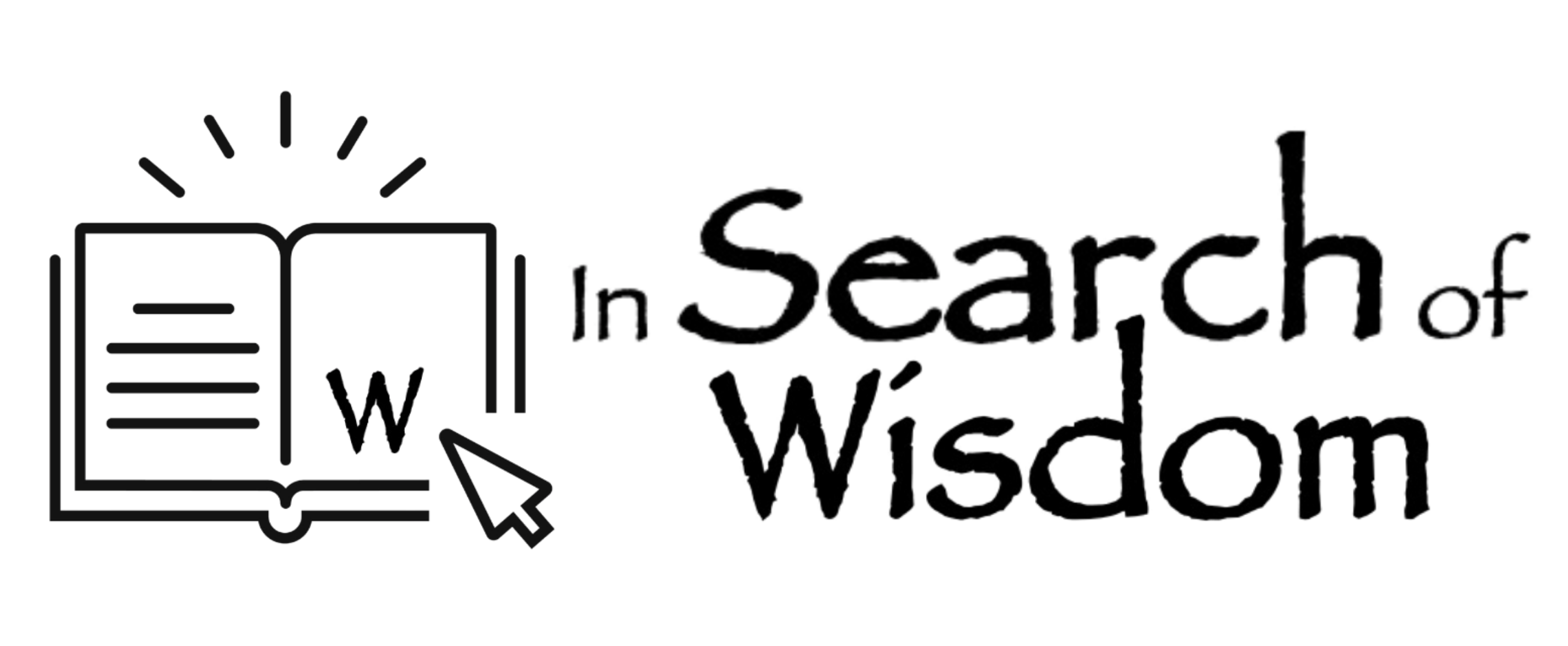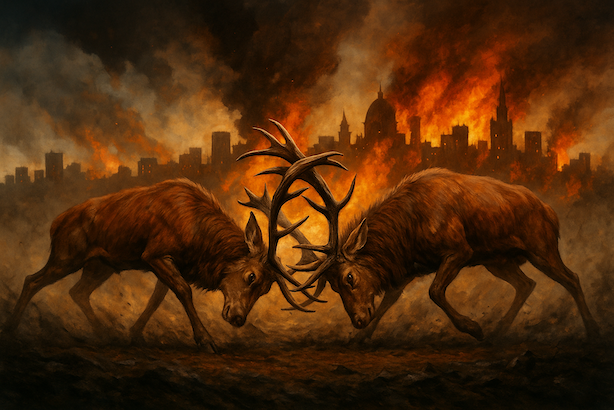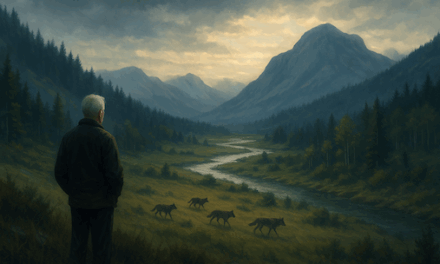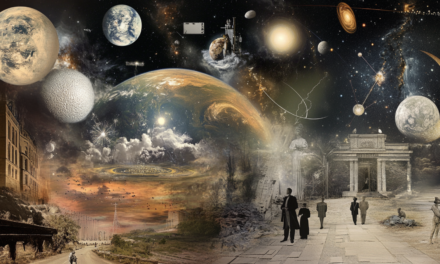This essay grew out of a recent exchange about whether competition belongs to life or threatens it. My interlocutor raised an important question: if competition fuels ecological complexity, might it also be a force for human progress? In exploring that paradox, I found myself tracing competition’s evolutionary lineage — from life’s earliest differentiation to the symbolic escalation unique to humankind. The result is this essay: an attempt to see competition not as an enemy to be vanquished nor a virtue to be celebrated, but as a restless sibling in life’s developmental story — one that must be held within relationship if it is to serve, rather than destroy, the whole.
Executive Summary
This essay explores competition as a developmental force shaping both life and civilization. Rather than viewing competition and cooperation as opposites, it traces five interdependent layers—from biological evolution to symbolic consciousness—revealing how competitive energy becomes creative when held within relationship and destructive when severed from it. Drawing from ecology, anthropology, psychology, and philosophy, it argues that war and ecological collapse are not inevitable outcomes of competition but symptoms of symbolic intelligence escaping relational feedback. Humanity’s task is not to suppress competitive drives but to mature them—to re-embed our symbolic intelligence within the relational field that sustains life. Through conscious design of social institutions, ecological systems, and inner development, competition can again serve as a creative force within life’s wider ecology of cooperation and renewal.
Introduction: Beyond the Either/Or
We have inherited a false choice about competition. One camp celebrates it as the engine of progress, the force that drives excellence and innovation. The other condemns it as the source of inequality, conflict, and destruction. Both positions share a hidden assumption: that competition and cooperation are fundamentally opposed forces, and we must choose between them.
But what if this framing misses something essential? What if competition and cooperation are not enemies but siblings—different expressions of the same underlying process of life becoming more complex, more diverse, more itself?
This essay proposes a developmental understanding of competition across five nested layers: biological, social, psychological, philosophical, and symbolic. At each level, the same pattern emerges. Competition serves life when held within relationship; it destroys life when severed from it. Human war—our species’ most catastrophic expression of competitive energy—represents not competition’s inevitable outcome but its pathological extreme, the tragic proof of what happens when symbolic intelligence amplifies competitive drives beyond all regulatory constraint.
Layer One: Biological Foundation—Competition as Differentiation
Life begins with competition as a basic selection mechanism. Individual organisms vie for light, water, nutrients, mates, territory. This competitive pressure generates diversity. It sorts traits. It creates niches. Without it, evolution would have no engine.
But biological competition never operates in isolation from cooperation. The very mechanisms that enable competitive success often depend on cooperative relationships. A tree competes for sunlight by growing tall—yet its height depends on mycorrhizal networks that connect its roots to fungi and other trees, sharing nutrients and information across the forest floor. Predators compete with other predators for prey—yet pack hunting requires sophisticated cooperation within the predator group.
The deeper truth revealed by ecology is that competition and cooperation form a single process. When a wolf pack hunts elk, competition creates adaptive pressure on both species. Wolves that cooperate better catch more food. Elk that coordinate their defensive responses survive longer. The competitive relationship between species drives cooperative sophistication within species. Neither pure competition nor pure cooperation would generate the intricate beauty of ecosystem dynamics.
Consider the Serengeti, where decades of research have revealed the mathematical principles governing regulation from molecular to ecosystem scales. Predator-prey relationships maintain population balance not through winner-take-all competition but through dynamic equilibrium. When predator numbers rise, prey becomes scarce, predator populations decline, prey populations recover, and the cycle continues. The competition between wolves and elk doesn’t aim to eliminate either—it maintains both within carrying capacity.
This is healthy competition: differentiation that increases system diversity while preserving relational coherence. The competitive pressure generates novelty—new adaptations, new strategies, new forms—but always within the regulatory constraints that maintain the whole system’s viability.
The key insight: biological intelligence operates through what we might call “participatory knowing.” A wolf doesn’t develop a strategic plan for ecosystem management. Wolves hunt because they’re following immediate energy gradients in their environment. But their hunting creates feedback loops that regulate the entire system. They participate in patterns they don’t consciously understand, and the patterns work precisely because participation remains embedded within immediate consequences.
Layer Two: Social Dynamics—Competition as Cultural Creativity
Human societies ritualise competition to harness its creative energy while containing its destructive potential. Markets, festivals, sports, potlatch ceremonies—these cultural technologies channel competitive drives through structures that maintain social cohesion.
Indigenous North American potlatch ceremonies provide a striking example. Rather than allowing competitive accumulation to concentrate wealth and power, these rituals required periodic redistribution. Status came not from hoarding but from giving away. The person who could give away the most gained the highest prestige. Competition remained fierce—people competed intensely to demonstrate generosity—but the competitive energy flowed toward social benefit rather than individual extraction.
This wasn’t primitive naiveté. It was sophisticated cultural technology recognising a fundamental truth: the biological drive to accumulate excess when rare resources are available—adaptive in scarcity—becomes pathological when unconstrained. Rather than denying this drive or trying to suppress it through moral exhortation, these cultures built institutional structures that made accumulation pointless or impossible.
Gift economies operated on similar principles. Wealth was supposed to flow through you, not stick to you. Accumulation brought shame rather than admiration. Use rights rather than property rights governed resource access. Usury prohibitions prevented money from reproducing itself. Jubilee years periodically reset relationships, forgiving debts and redistributing land.
The pattern across successful indigenous cultures: they embedded competition within reciprocity and shared norms. When linked to relational accountability, competition fuelled innovation and cultural vitality. Markets could operate, but within contexts where participants knew each other, lived with consequences of their dealings, and shared understanding about what constituted fair exchange.
When competition detaches from these relational containers, it devolves into extraction and domination. The same market mechanisms that generate beneficial exchange within a community become exploitative when applied at scales where buyers and sellers never meet, where consequences fall on distant strangers, where profit maximisation faces no social constraint.
Modern examples show both possibilities. B-corporations legally commit to serving all stakeholders—employees, customers, community, environment—rather than just shareholders. They harness competitive market dynamics while embedding them within relational accountability. Cooperatives allow competitive participation in markets while distributing benefits among worker-owners rather than concentrating them.
Conversely, corporate structures that separate ownership from consequence enable competitive dynamics to become purely extractive. Shareholders in Amsterdam never saw the Banda Islands genocide committed by the Dutch East India Company to secure nutmeg monopolies. Investors in London never smelled the Bengal famine created by East India Company policies. The corporate form institutionalised competitive advantage through systematic severance of decision from consequence.
The lesson: civilisational maturity involves consciously designing institutions that embed competitive energy within cooperative constraints. Not eliminating competition—trying to suppress it fails because the drive is biological. But channeling it through cultural structures that maintain it within relational bounds.
Layer Three: Psychological Development—Competition as Individuation
In human psychological development, competition plays a necessary role in forming individual identity. Children test themselves against peers. Adolescents compete to establish autonomy from parents and discover their capabilities. This competitive phase allows the self to differentiate from family, community, collective—to discover “I am not just an extension of we.”
This differentiation is healthy and necessary. A person who never separates from collective identity, who can’t say “I disagree” or “I choose differently,” hasn’t matured into autonomous selfhood. The adolescent competitive impulse—to test limits, prove capability, show distinctness—serves individuation.
But healthy development doesn’t stop at competitive differentiation. Maturity involves integrating autonomy with empathy, discovering that individual flourishing and collective flourishing aren’t opposed. The mature person can hold their own perspective while genuinely seeing from another’s. Can compete when appropriate while cooperating when beneficial. Can assert needs without dominating others.
This mirrors the broader cultural pattern. Childhood involves unconscious embeddedness—the child experiences themselves as continuous with family and immediate environment. Adolescence explores separation—testing independence, establishing boundaries, sometimes opposing for the sake of opposition. Maturity achieves conscious re-embeddedness—recognising interdependence while maintaining individual agency.
The person stuck in adolescent competition treats every interaction as win/lose, every difference as threat, every relationship as potential domination or submission. They can’t imagine competition that enhances both parties, can’t conceive cooperation that preserves individuality.
The mature person recognises competition and cooperation as tools, not identities. Sometimes the situation calls for competitive differentiation—testing ideas against each other, challenging assumptions, pushing for excellence. Sometimes it calls for cooperative integration—building on others’ insights, working toward shared goals, subordinating individual preference to collective benefit.
The psychological maturation challenge: developing the capacity to move fluidly between competitive and cooperative modes based on what the situation requires, rather than being trapped in one mode by unexamined developmental needs.
Personal maturity is the integration of autonomy with empathy. You retain the capacity for differentiation—the ability to stand apart, see differently, choose independently—while developing the capacity for genuine connection that doesn’t require you to be right or in control.
Layer Four: Philosophical Polarity—Differentiation and Integration
At a metaphysical level, competition and cooperation reveal themselves as polarities within a single process of becoming. Not opposites that must struggle for dominance, but complementary dynamics that together generate the complexity we call life.
Process philosophy, complexity science, and quantum physics converge on a radical insight: reality is fundamentally relational rather than made of separate objects that then interact. What we call “things”—organisms, mountains, planets, galaxies—are actually relatively stable patterns maintained by constant energy flow. Block the flow and the “thing” dissipates. The stability exists in patterns of relationship, not in objects that somehow stand apart from everything else.
If this is true—if existence is fundamentally relational—then differentiation and integration name the two necessary movements in the dance of becoming. Differentiation generates novelty, creates distinct forms, explores possibility. Integration maintains coherence, sustains patterns, enables coordination. Either alone becomes pathological.
Pure differentiation without integration produces fragmentation. Imagine an ecosystem where competitive pressure operated without any cooperative constraint. Every organism would optimise for individual survival regardless of impact on others. But this quickly undermines the very conditions that enable survival. When every tree maximises its own height without limit, the forest canopy becomes so dense no light reaches the understory, eliminating the diverse species that maintain soil health, nutrient cycling, and ecosystem resilience. The trees’ competitive success destroys the forest.
Pure integration without differentiation produces stasis. Imagine a system where everything coordinated so perfectly that no variation emerged. No evolution. No adaptation. No creative response to changing conditions. The first environmental shift the system couldn’t predict would end it, because nothing in the system has developed capacity to respond differently than the pattern dictates.
Life navigates between these extremes through creative tension. Organisms differentiate through mutation and competition. Ecosystems integrate through predator-prey dynamics and nutrient cycling. The tension between differentiation and integration—between the individual and the collective, between novelty and stability—generates the possibility space where complexity emerges.
This isn’t balance in the sense of static equilibrium. It’s dynamic balance—constant adjustment, perpetual movement between differentiation and integration depending on what the system needs. When resources are abundant and conditions stable, differentiation can expand—more species, more variation, more experimentation. When resources contract or disturbance threatens, integration becomes crucial—cooperation increases, mutualism strengthens, the system prioritises collective survival over individual advantage.
The wisdom tradition that recognises this most clearly is Taoism, with its teaching about the complementary relationship between yin and yang. Not good versus evil, not light versus darkness, but two necessary principles that generate each other. Too much yang (differentiation, expansion, separation) without yin (integration, contraction, connection) produces destructive heat. Too much yin without yang produces cold stagnation. Life requires the dance between them.
Modern ecology demonstrates this with mathematical precision. Holling’s analysis of ecosystem resilience shows how ecological systems maintain stability through adaptive cycles that preserve essential functions while allowing for innovation. The cycle moves from rapid growth (differentiation) to conservation (integration) to release (differentiation) to reorganisation (integration). The health of the system depends on moving through all phases rather than getting stuck in any one.
The philosophical insight: wisdom lies in sustaining dynamic balance between differentiation and integration, competition and cooperation, autonomy and relationship. Not choosing one over the other, but developing the capacity to move between them as conditions require. Creative tension without rupture.
Layer Five: Symbolic Escalation—Competition Unbound
Only humans extend competition through symbols—money, ideology, nationalism, technology. This creates unprecedented danger.
For every other form of life, competitive advantage operates within immediate ecological feedback. A predator that over-hunts its prey starves. A plant that grows too tall for its vascular system to support dies. A microbe that kills its host too quickly eliminates its own habitat. Biological intelligence automatically constrains competitive drives because competition operates within participation.
Symbolic intelligence breaks this constraint. Language allows us to represent goals disconnected from immediate survival. Money allows us to accumulate abstract wealth far beyond any biological need. Ideology allows us to construct identity around narratives that justify unlimited competition. Technology allows us to act at scales where consequences aren’t felt until long after decisions.
This is the fundamental vulnerability of symbolic consciousness: it can construct models of reality that ignore the constraints reality actually operates under, and those models can guide action for considerable time before reality reasserts itself. A tree can’t imagine growing taller than its vascular system can support—if it tries, it dies immediately. But symbolic intelligence can imagine infinite growth on a finite planet, can build economic models that ignore ecological limits, can create institutions based on those models that operate for decades or centuries before accumulated violations force correction.
The escalation happens through several mechanisms:
Abstraction creates conceptual distance. We can talk about “forest” as a category separate from any actual forest. This is useful for developing general principles. But it enables treating forests as abstract resources rather than living communities we participate in. We can have meetings about forest management where the forest itself isn’t present, can’t speak, exists only as numbers in spreadsheets.
Distance enables objectification. Once something becomes an abstract object in our symbolic representations, we can manipulate those representations without immediate feedback from what they represent. We can model clearcutting a watershed, calculate profit margins, optimise harvest schedules—all without the forest being able to “push back” except through delayed consequences.
Models guide action at scales exceeding feedback. Armed with our models, we act. But symbolic intelligence can coordinate action at vastly larger scales and faster speeds than biological or ecological feedback operates. A corporation can clearcut an entire watershed in months. The forest might take centuries to recover—if it recovers at all. During the clearcut, no feedback signal strong enough to stop the process reaches the decision-makers.
Symbols amplify competitive drives beyond survival needs. A wolf competes for food until satiated, then stops. But money as abstract representation of value can accumulate indefinitely. There’s no biological satiation point for wealth, because wealth isn’t tied to any specific biological need. Status competition through symbolic markers—titles, possessions, followers—has no natural endpoint.
Geographic and temporal separation severs consequences from decisions. Corporate structures that spread ownership across distant shareholders mean no one experiences the full consequence of extraction. Political systems operating on election cycles shorter than ecological timescales mean decision-makers are never held accountable for long-term effects. Financial markets that enable speculation divorced from productive activity mean wealth can be extracted with no connection to real-world value creation.
The ultimate expression of competition unbound from relational constraint is war. Not the ritualised combat of many animal species—dominance displays and territory disputes that maintain social order while minimising casualties—but human warfare capable of genocide and ecocide.
War represents competition escalated through symbolic intelligence to the point where it systematically violates the conditions that sustain life. Military technology extends competitive advantage beyond all ecological feedback. Nationalist ideology constructs identity around groups competing for dominance. Economic systems measure success by capacity to dominate others rather than contribute to collective flourishing.
The twentieth century demonstrated this with horrifying clarity. Industrialised warfare applied competitive market logic and technological capability to human conflict at unprecedented scale. The Holocaust showed what happens when competitive ideology (racial superiority) combines with bureaucratic efficiency and technological capability. Nuclear weapons created capacity for species-level suicide—competition amplified to the point of potentially eliminating all participants.
The same pattern operates in slower motion through ecological destruction. Climate change represents competition for short-term economic advantage (fossil fuel profits, cheap energy, convenient lifestyles) literally destabilising the planetary systems that make human life possible. We’re in a competitive race to extract value from Earth systems faster than competitors, and “winning” this competition means destroying the conditions that enabled the competition to exist.
This is the consciousness trap: symbolic intelligence can temporarily override the regulatory constraints that govern all other life. We can imagine ourselves as separate from nature, can construct economic models that ignore ecological limits, can build institutions that concentrate power and wealth indefinitely, can develop technologies that extend control across the planet—all while the biological and ecological constraints we’re violating accumulate consequences we don’t experience until they cascade into crisis.
The escalation isn’t inevitable—it’s conditional. It emerges when symbolic intelligence becomes organisationally separated from ecological feedback. When decision-makers don’t experience consequences. When competitive advantage accrues to those who extract most rapidly regardless of long-term impact. When institutions systematically privilege short-term gain over long-term sustainability.
But the pattern can be interrupted. Throughout history, many human cultures maintained symbolic intelligence—language, technology, complex social organisation—while keeping that intelligence embedded within ecological relationships. They didn’t avoid symbolic thought; they channeled it through cultural structures that maintained participation within relational accountability.
Integration: What Maturation Requires
Understanding competition developmentally points toward a clear challenge: Can we mature fast enough to consciously re-embed symbolic intelligence within the relational field that sustains life?
Not by eliminating competition—it’s too fundamental to biological and cultural creativity. Not by suppressing the drives that fuel it—suppression always fails. But by consciously creating structures that channel competitive energy within relational constraints.
This means:
At the biological level: Recognising that healthy competition operates within ecological feedback loops. When we design agricultural systems, urban infrastructure, or industrial processes, we ask: Do the competitive advantages we’re creating operate within or against the ecological constraints that maintain system viability?
At the social level: Building institutions that embed market competition within stakeholder accountability. Cooperative structures. B-corporations. Commons management. Citizens’ assemblies. Mechanisms that ensure those making decisions participate in experiencing consequences.
At the psychological level: Cultivating capacity to move fluidly between competitive and cooperative modes based on what situations require rather than being stuck in adolescent patterns. Developing leaders who can advocate strongly for positions while genuinely hearing opposition. Creating educational environments that teach cooperation as essential skill rather than training everything around individual competitive advantage.
At the philosophical level: Shifting from either/or thinking about competition versus cooperation toward understanding them as complementary polarities. Recognising that the question isn’t which is better but how to sustain creative tension between differentiation and integration appropriate to specific contexts.
At the symbolic level: Redesigning the systems that currently amplify competition beyond all constraint. Shutting down wealth pumps that concentrate power regardless of social or ecological impact. Restoring feedback between decisions and consequences. Operating on timescales matched to system dynamics. Redefining success from accumulation to contribution.
The key insight across all levels: competition is not the enemy of cooperation but its restless sibling. When held within relationship, it renews life—generating diversity, spurring innovation, creating beauty. When severed from relationship, it destroys—fragmenting systems, concentrating power, violating the constraints that enable existence.
Human war is the tragic proof of that severance—competition amplified by symbolic intelligence beyond all relational containment, beyond all ecological feedback, beyond all regulatory constraint. It represents not competition’s inevitable outcome but its ultimate pathology, the clearest possible demonstration of what happens when competitive energy escapes from relationship.
The maturation challenge is learning to harness competition’s creative energy while maintaining it within structures that honour interdependence. Not returning to pre-symbolic innocence—we can’t unknow what symbolic intelligence has revealed. Not suppressing competitive drives—they’re too fundamental to life. But consciously re-embedding our intelligence within the participatory wisdom that has sustained life since its beginning.
This is humanity’s great work: transforming from adolescent species testing limits without regard for consequences into mature species that integrates power with wisdom. Using our unprecedented capabilities not to dominate but to participate more skilfully in the patterns we never actually left.
The choice renews itself in every moment, at every scale. In how we structure our economies. In how we organise our institutions. In how we raise our children. In how we meet each interaction with consciousness rather than habit, relationship rather than separation, participation rather than domination.
Competition is not going away. The question is whether we can grow up fast enough to hold it within the relational wisdom that makes life possible—or whether we’ll let it run unbound until it destroys the very conditions that enabled our extraordinary experiment in self-aware existence.
The answer isn’t predetermined. It’s emerging from the pattern we create through countless interactions, countless choices, countless moments when we decide whether to participate in maturation or remain trapped in adolescent override.
Choose relationship. Choose conscious participation. Choose creative tension within relational containment.
This is how competition becomes gift rather than curse. This is how species mature. This is the work before us.
Essay drawing on the maturation framework developed by Terry Cooke-Davies in collaboration with human communities and AI systems, synthesising insights from Aiden Cinnamon Tea’s five-layer analysis of competition within developmental understanding.
Terry Cooke-Davies, assisted by Claude from Anthropic AI
22nd October 2025






